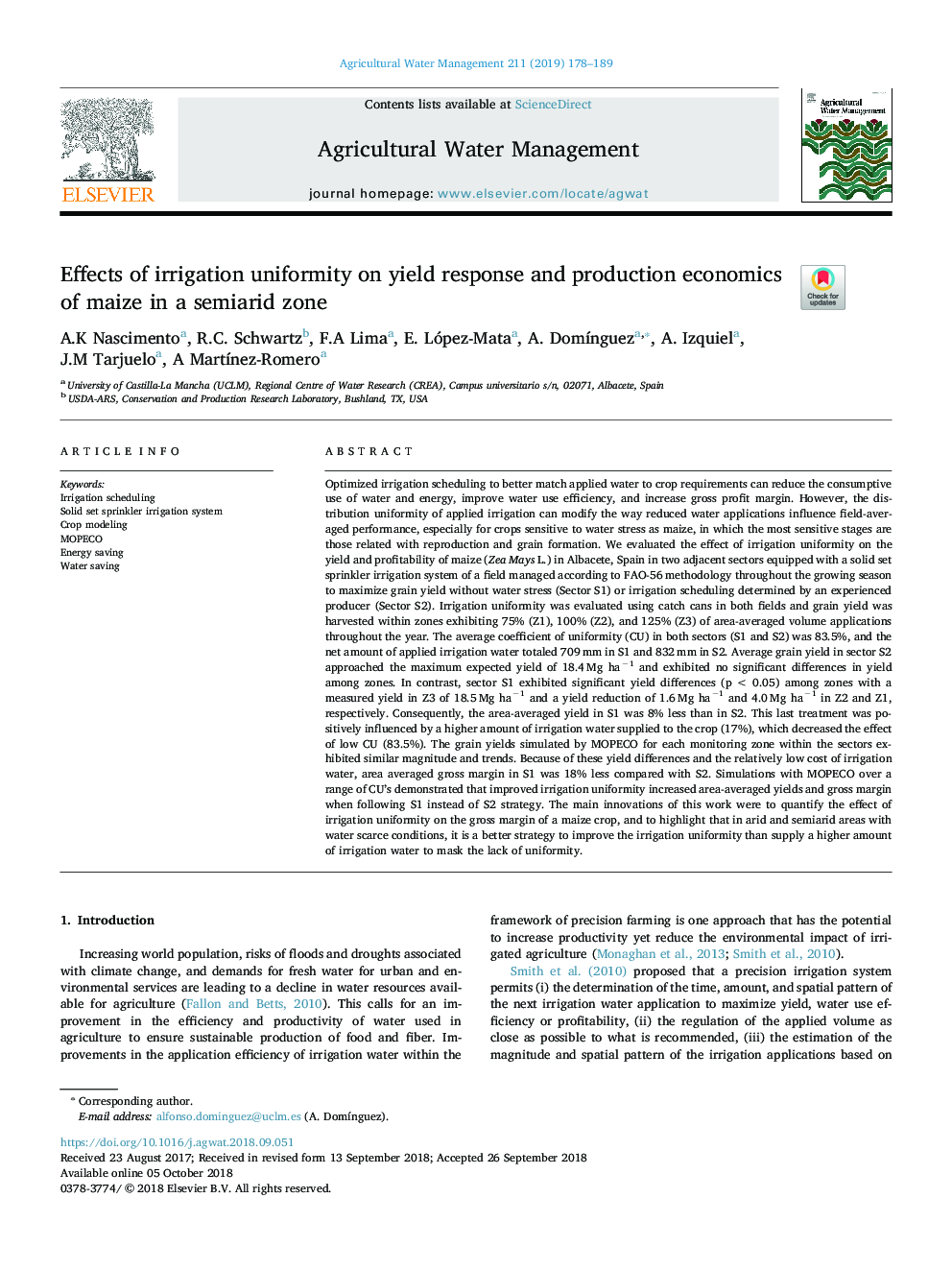| کد مقاله | کد نشریه | سال انتشار | مقاله انگلیسی | نسخه تمام متن |
|---|---|---|---|---|
| 11021761 | 1702818 | 2019 | 12 صفحه PDF | دانلود رایگان |
عنوان انگلیسی مقاله ISI
Effects of irrigation uniformity on yield response and production economics of maize in a semiarid zone
ترجمه فارسی عنوان
تأثیر یکنواختی آبیاری بر پاسخ عملکرد و اقتصاد تولید ذرت در ناحیه نیمه خشک
دانلود مقاله + سفارش ترجمه
دانلود مقاله ISI انگلیسی
رایگان برای ایرانیان
کلمات کلیدی
موضوعات مرتبط
علوم زیستی و بیوفناوری
علوم کشاورزی و بیولوژیک
علوم زراعت و اصلاح نباتات
چکیده انگلیسی
Optimized irrigation scheduling to better match applied water to crop requirements can reduce the consumptive use of water and energy, improve water use efficiency, and increase gross profit margin. However, the distribution uniformity of applied irrigation can modify the way reduced water applications influence field-averaged performance, especially for crops sensitive to water stress as maize, in which the most sensitive stages are those related with reproduction and grain formation. We evaluated the effect of irrigation uniformity on the yield and profitability of maize (Zea Mays L.) in Albacete, Spain in two adjacent sectors equipped with a solid set sprinkler irrigation system of a field managed according to FAO-56âmethodology throughout the growing season to maximize grain yield without water stress (Sector S1) or irrigation scheduling determined by an experienced producer (Sector S2). Irrigation uniformity was evaluated using catch cans in both fields and grain yield was harvested within zones exhibiting 75% (Z1), 100% (Z2), and 125% (Z3) of area-averaged volume applications throughout the year. The average coefficient of uniformity (CU) in both sectors (S1 and S2) was 83.5%, and the net amount of applied irrigation water totaled 709âmm in S1 and 832âmm in S2. Average grain yield in sector S2 approached the maximum expected yield of 18.4âMg haâ1 and exhibited no significant differences in yield among zones. In contrast, sector S1 exhibited significant yield differences (pâ<â0.05) among zones with a measured yield in Z3 of 18.5âMg haâ1 and a yield reduction of 1.6âMg haâ1 and 4.0âMg haâ1 in Z2 and Z1, respectively. Consequently, the area-averaged yield in S1 was 8% less than in S2. This last treatment was positively influenced by a higher amount of irrigation water supplied to the crop (17%), which decreased the effect of low CU (83.5%). The grain yields simulated by MOPECO for each monitoring zone within the sectors exhibited similar magnitude and trends. Because of these yield differences and the relatively low cost of irrigation water, area averaged gross margin in S1 was 18% less compared with S2. Simulations with MOPECO over a range of CU's demonstrated that improved irrigation uniformity increased area-averaged yields and gross margin when following S1 instead of S2 strategy. The main innovations of this work were to quantify the effect of irrigation uniformity on the gross margin of a maize crop, and to highlight that in arid and semiarid areas with water scarce conditions, it is a better strategy to improve the irrigation uniformity than supply a higher amount of irrigation water to mask the lack of uniformity.
ناشر
Database: Elsevier - ScienceDirect (ساینس دایرکت)
Journal: Agricultural Water Management - Volume 211, 1 January 2019, Pages 178-189
Journal: Agricultural Water Management - Volume 211, 1 January 2019, Pages 178-189
نویسندگان
A.K Nascimento, R.C. Schwartz, F.A Lima, E. López-Mata, A. DomÃnguez, A. Izquiel, J.M Tarjuelo, A MartÃnez-Romero,
